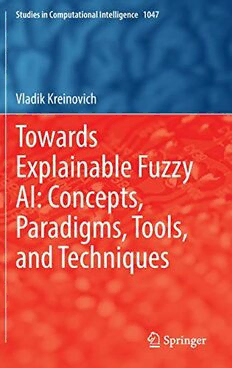Table Of ContentStudies in Computational Intelligence 1047
Vladik Kreinovich
Towards
Explainable Fuzzy
AI: Concepts,
Paradigms, Tools,
and Techniques
Studies in Computational Intelligence
Volume 1047
SeriesEditor
JanuszKacprzyk,PolishAcademyofSciences,Warsaw,Poland
The series “Studies in Computational Intelligence” (SCI) publishes
new developments and advances in the various areas of computational
intelligence—quickly and with a high quality. The intent is to cover the theory,
applications, and design methods of computational intelligence, as embedded in
the fields of engineering, computer science, physics and life sciences, as well as
themethodologiesbehindthem.Theseriescontainsmonographs,lecturenotesand
editedvolumesincomputationalintelligencespanningtheareasofneuralnetworks,
connectionist systems, genetic algorithms, evolutionary computation, artificial
intelligence, cellular automata, self-organizing systems, soft computing, fuzzy
systems,andhybridintelligentsystems.Ofparticularvaluetoboththecontributors
and the readership are the short publication timeframe and the world-wide
distribution,whichenablebothwideandrapiddisseminationofresearchoutput.
IndexedbySCOPUS,DBLP,WTIFrankfurteG,zbMATH,SCImago.
AllbookspublishedintheseriesaresubmittedforconsiderationinWebofScience.
Vladik Kreinovich
Towards Explainable Fuzzy
AI: Concepts, Paradigms,
Tools, and Techniques
VladikKreinovich
DepartmentofComputerScience
TheUniversityofTexasatElPaso
ElPaso,TX,USA
ISSN 1860-949X ISSN 1860-9503 (electronic)
StudiesinComputationalIntelligence
ISBN 978-3-031-09973-1 ISBN 978-3-031-09974-8 (eBook)
https://doi.org/10.1007/978-3-031-09974-8
©TheEditor(s)(ifapplicable)andTheAuthor(s),underexclusivelicensetoSpringerNature
SwitzerlandAG2022
Thisworkissubjecttocopyright.AllrightsaresolelyandexclusivelylicensedbythePublisher,whether
thewholeorpartofthematerialisconcerned,specificallytherightsoftranslation,reprinting,reuse
ofillustrations,recitation,broadcasting,reproductiononmicrofilmsorinanyotherphysicalway,and
transmissionorinformationstorageandretrieval,electronicadaptation,computersoftware,orbysimilar
ordissimilarmethodologynowknownorhereafterdeveloped.
Theuseofgeneraldescriptivenames,registerednames,trademarks,servicemarks,etc.inthispublication
doesnotimply,evenintheabsenceofaspecificstatement,thatsuchnamesareexemptfromtherelevant
protectivelawsandregulationsandthereforefreeforgeneraluse.
Thepublisher,theauthors,andtheeditorsaresafetoassumethattheadviceandinformationinthisbook
arebelievedtobetrueandaccurateatthedateofpublication.Neitherthepublishernortheauthorsor
theeditorsgiveawarranty,expressedorimplied,withrespecttothematerialcontainedhereinorforany
errorsoromissionsthatmayhavebeenmade.Thepublisherremainsneutralwithregardtojurisdictional
claimsinpublishedmapsandinstitutionalaffiliations.
ThisSpringerimprintispublishedbytheregisteredcompanySpringerNatureSwitzerlandAG
Theregisteredcompanyaddressis:Gewerbestrasse11,6330Cham,Switzerland
Preface
What this book is about and who is the intended audience. This book is an
introduction to fuzzy approach to explainable AI. The intent is that the material
shouldbeunderstandableevenforundergraduatestudents—and,ofcourse,graduate
students,researchers,andpractitionerswillalsohopefullybenefitfromthismaterial.
NeedforexplainableAI.WhatisexplainableAIandwhydoweneeditinthefirst
place?
ModernAItechniques—especiallydeeplearning—provide,inmanycases,very
goodrecommendationswhereaself-drivingcarshouldgo,whethertogiveacompany
aloan,etc.Theproblemisthatthesetechniquesarenot(yet)perfect.
In some cases, the recommendations generated by an AI system are not good.
Ofcourse,asthefamousMarilynMonroemoviesays,“Nobody’sperfect”.Human
expertsarenotperfecteither.However,whenahumanexpert—beitabankingofficial
oramedicaldoctor—makesarecommendation,heorshecan,ifasked,providean
explanation.Ifyoufindtheexplanationnotsufficientlyconvincing,youcanaskfor
someoneelse’sadvice.
Unfortunately,recommendationsprovidedbyanAIsystem(suchasadeepneural
network)usuallycomewithoutanexplanation.Sowecannotsoeasilyseparategood
andbadadvice.ItisthereforedesirabletomakeAImoreexplainable.
Why fuzzy techniques. Providing an explanation means finding natural language
rules and ideas which are, in some reasonable sense, equivalent to the numerical
resultsprovidedbytheAItools.Theproblemofconnectingnaturallanguagerules
and numerical decisions is known since 1960s. Then, the need was recognized to
incorporateexpertknowledgeintocontrolanddecision-making.
Experts use imprecise words like “small”. For this incorporation, a special
technique was invented—known as fuzzy techniques. This technique led to many
successfulapplications.Itisthereforereasonabletousethesetechniquesindesigning
explainableAI.
What we study in this book. If we knew how to make AI explainable, teaching
this class would be easier. We would just teach the corresponding algorithms and
methods.
v
vi Preface
Atpresent,explainableAIremainslargelyanultimategoal.Wedonotyetknow
whichtoolswillworkbetter.So,insteadofstudyingspecifictools,itmakessenseto
studythefoundationsforthesetools,sothatwewillknowwhyweneedtousethese
tools,andwewillknowwhichtoolsarebetterinwhichsituations.Thiswillhelpus
selectappropriatetoolsformakingcurrentAIapplicationsmoreexplainable.
Firsttopic:Introductiontofuzzytechniques.Wewanttobetterunderstandhow
fuzzy techniques can help with explainable AI. For this, we need to have a good
understandingofthesetechniques.Wewilllearnthecorrespondingtechniquesand
howtheyareusedincontrolandinotherapplications.
Wewillalsotrytomakethesetechniquesthemselvesmoreexplainable.Namely
wewillexplainthefirst-principlemotivationsforthesetechniques.
Wewillstudyallthreemainstagesoffuzzytechniques:
(cid:129)
describingtheoriginalimprecisewordslike“small”innumericalterms,
(cid:129)
combiningthecorrespondingnumbers;todescribeBoolean(and-andor-)combi-
nationsofthecorrespondingproperties,special“and”and“or”operationsareused
forthis;
(cid:129)
“defuzzification”—transforming imprecise recommendations into a precise
controlvalue.
Second topic: Which version of fuzzy technique to select. In all three stages
of fuzzy techniques, there are several options. Empirically, in different situations,
differentoptionsworkbest.Thismakessense,sinceindifferentsituations,wehave
different objectives. For example, if we launch a single drone to inspect an area,
themainobjectiveistomaximizetheprobabilitythatitsmissionsucceeds.Onthe
otherhand,ifwelaunchaswarmofdronestoinspectthesamearea,itisprobably
OKifoneofthemdoesnotdomuch—aslongas,onaverage,theoverallmissionis
successful.
How do we select the best techniques? In some cases, we have finitely many
parameters. So, we need to find the best values of these parameters. To find the
largest and the smallest values of a function of several such variables, we can use
calculus.(Donotworryifyouhaveforgottensomeofit,wewillrefresh).
Inmanyothercases,however,weneedtoselectafunction—e.g.thebest“and”-
and “or”-operations. There is a natural generalization of calculus that deals with
such optimization problems. It is known as variational calculus, and it is actively
usedincontrol.Wewilllearnthebasicsofthesetechniques.Asanexample,wewill
usethistechniquetocomeupwithoptimal“and”-and“or”-operationsforthetwo
above-describeddronesituations.
Thirdtopic:Towardsexplainablemachinelearning.Theultimategoalistomake
theresults ofmachinelearning(andotherAItechniques)explainable.Wearestill
workingonthis.
Meanwhile,animportanthelpwouldbetomakethemachinelearningtechniques
themselvesexplainable.Atpresent,inmanycases,theonlyreasonweselectsome
techniquesandsomeparametersofthesetechniquesisthatthesetechniquesempir-
icallyworkwellonseveralproblems.Thisisnotasconvincingaswhenweprove
Preface vii
thatthesetechniquesare,insomereasonablesense,optimal.Wewillanalysedeep
learningfromthisviewpoint.
Finalwordbeforetheactualmaterialstarts:Enjoy!
ElPaso,TX,USA VladikKreinovich
December2021
Contents
1 WhyExplainableAI?WhyFuzzyExplainableAI?WhatIs
Fuzzy? ........................................................ 1
1.1 WhyExplainableAI? ...................................... 1
1.2 Why Fuzzy Techniques Seem a Reasonable Approach
forExplainableAI ......................................... 6
1.3 WhatIsFuzzyMethodology ................................ 8
1.4 SummaryofFuzzyMethodology ............................ 17
1.5 Exercises ................................................. 19
2 Defuzzification ................................................. 21
2.1 FormulationoftheProblem:Reminder ....................... 21
2.2 MainIdeaandtheResultingFormula ......................... 21
2.3 IntegralForm ............................................. 27
2.4 Important Comment: Centroid Defuzzification Is Not
aPanacea ................................................ 29
2.5 Exercises ................................................. 32
2.6 Self-Test1 ............................................... 33
3 WhichFuzzyTechniques? ....................................... 35
3.1 WhatWeStudyinThisChapter ............................. 35
3.2 InterpolationShouldBeRobust ............................. 36
3.3 WhichInterpolationIstheMostRobust ...................... 39
3.4 “And”-and“Or”-OperationsMustBeRobustToo .............. 43
3.5 WhichIstheMostRobust“And”-Operation ................... 44
3.6 WhichIstheMostRobust“Or”-Operation .................... 47
3.7 GroupRobustnessVersusIndividualRobustness ............... 50
3.8 WhichInterpolationIstheMostIndividuallyRobust ........... 51
3.9 TheMostIndividuallyRobust“And”-Operation ............... 56
3.10 RobustnessVersusIndividualRobustness:Example ............ 58
3.11 TheMostIndividuallyRobust“Or”-Operation ................. 61
3.12 GeneralConclusion ........................................ 63
3.13 Exercises ................................................. 64
ix
x Contents
4 SoHowCanWeDesignExplainableFuzzyAI:Ideas .............. 67
4.1 MachineLearningRevisited ................................ 67
4.2 Exercises ................................................. 71
4.3 Self-Test2 ............................................... 71
5 HowtoMakeMachineLearningItselfMoreExplainable .......... 73
5.1 How Can We Make Machine Learning Itself More
Explainable:Idea .......................................... 73
5.2 SelectionofanActivationFunction .......................... 74
5.3 SelectionofPooling ....................................... 78
5.4 WhatAboutFuzzy? ....................................... 79
5.5 Exercises ................................................. 80
5.6 Self-Test3 ............................................... 80
6 FinalSelf-Test ................................................. 83
AppendixA:TermsUsedintheBook(inAlphabeticOrder) ........... 85
AppendixB: WhyDoWeNeed...?(inAlphabeticOrder) ............. 89
AppendixC:SolutionstoExercises ................................. 93
AppendixD:SolutionstoSelf-Tests ................................. 111
AppendixE: AdditionalReadings ................................... 129

